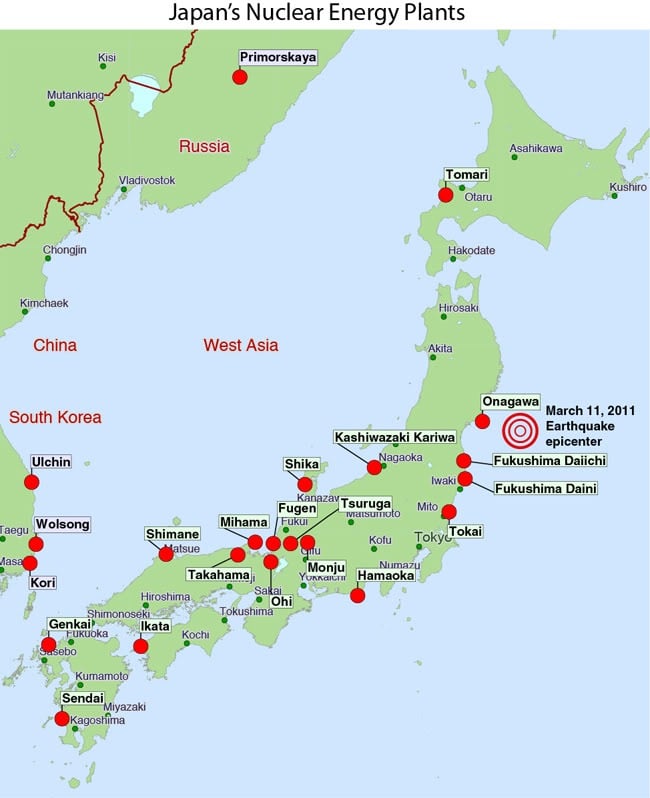Most of us have heard of Fukushima, but few have heard of Onagawa—the Japanese nuclear power plant that didn’t melt down. This powerful case study shows safety in action, and the power of a strong, positive safety culture. But first, let’s revisit Fukushima…
Disaster Strikes
Rewind to March 11, 2011. An 8.9 magnitude earthquake hits just off the coast of Japan.
The results of the earthquake and 14-meter tsunami are devastating to say the least—nearly 20,000 die and thousands more are left injured and missing.
The Fukushima Nuclear Power Plant is hit hard. The resulting flooding and emergency failures lead to the most severe nuclear accident since Chernobyl.
But was Fukushima simply the result of an unfortunate natural disaster, or could it have been prevented?
Investigations Ensue
An independent investigation report handed down in 2012 found that the causes of the incident had been foreseeable, and that the Fukushima plant operator, Tokyo Electric Power Company (TEPCO), had failed to meet basic safety requirements such as conducting adequate risk assessments, preparing for containing collateral damage, and developing evacuation plans.
The investigation found that the company had cut corners when it came to safety. They had shaved the height of the sea wall to reduce the cost associated with getting new equipment into the plant, and there was a history of ignoring issues raised by employees
The report contained damning statements, including:
“What must be admitted – very painfully – is that this was a disaster ‘Made in Japan…”
“The Fukushima nuclear power plant accident was the result of collusion between the government, the regulators and TEPCO, and the lack of governance by said parties…”
“They effectively betrayed the nation’s right to be safe from nuclear accidents. Therefore, we conclude that the accident was clearly ‘man-made’.”
The Fukushima disaster highlights an example of a culture where it was taboo to ‘rock the boat’ especially around incident reporting, raising safety concerns or questioning leadership decisions around risk management.
Now broader cultural factors obviously play a role here too. In fact the report indicated that
“..the fundamental causes were to be found in the ingrained conventions of Japanese culture: a reflexive obedience; a reluctance to question authority; and a devotion to ‘sticking with the program’.”
But, this in itself cannot excuse the devastation faced at Fukushima. In fact, there were other power plants closer to the epicenter of the earthquake that suffered much less damage and devastation.
What about Onagawa?
Enter Onagawa—the Japanese nuclear power plant that didn’t melt down, operated by Tohoku Electric.
Onagawa was the most quickly constructed nuclear power plant in the world. It was shut down following the earthquake and tsunami, and eventually decommissioned in 2018, but on that fateful day in 2011, it saw a much different result, despite being almost twice as close to the epicentre as Fukushima.
During the earthquake, Onagawa experienced high levels of ground shaking, amongst the strongest of any plant affected by the quake and some flooding from the tsunami that followed
Yet, all three reactors successfully withstood the earthquake and tsunami without incident

Onagawa’s Keys to Success
An inspection in 2012 stated that ‘the structural elements of the Nuclear Power Station were remarkably undamaged given the magnitude of ground motion experienced and the duration and size of this great earthquake’
So how is it that the same event led to such drastically different results for Fukushima and Onagawa?
Well, the difference was in the planning and the ongoing safety culture.
Firstly, Onagawa was built on higher ground. They built a high seawall —14.8metres. All safety systems functioned as designed and the reactors automatically shut down without damage.
In fact, following the tsunami, somewhere between 200-300 residents of the town who lost their homes took refuge in the Onagawa nuclear plant gymnasium.
Secondly, the leadership team was committed to safety. They sought to learn from not only other global nuclear disasters, but also tsunamis all around the world, and implemented enhanced safety processes as a result
A statement by the US Nuclear Regulatory Commission sums it up simply:
“the core values and behaviors resulting from a collective commitment by leaders and individuals to emphasize safety over competing goals to ensure protection of people and the environment.”
The safety culture at Onagawa, was much more mature than Fukushima and leadership invested in the safety culture to ensure that the plant could withstand known risks like earthquakes and tsunamis, and that its people and community could remain safe.
Summary
Everyone knows the story Fukushima, but few people are familiar with the story of the Onagawa . With most other factors being similar, it was leadership’s focus on safety, and the resulting practices and safety culture that saved the day.
What lessons can you learn from this story? And how might you apply these to the safety culture in your business?
Want to learn more? This article is based on information obtained from an article published by Bulletin of the Atomic Scientists. It’s a great read—check it out for a more in-depth summary.

